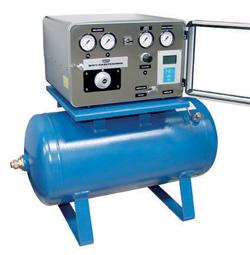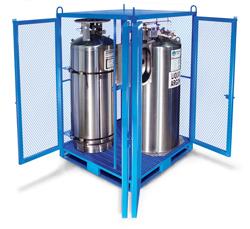President
- FMA
- The Fabricator
- FABTECH
- Canadian Metalworking
Categories
- Additive Manufacturing
- Aluminum Welding
- Arc Welding
- Assembly and Joining
- Automation and Robotics
- Bending and Forming
- Consumables
- Cutting and Weld Prep
- Electric Vehicles
- En Español
- Finishing
- Hydroforming
- Laser Cutting
- Laser Welding
- Machining
- Manufacturing Software
- Materials Handling
- Metals/Materials
- Oxyfuel Cutting
- Plasma Cutting
- Power Tools
- Punching and Other Holemaking
- Roll Forming
- Safety
- Sawing
- Shearing
- Shop Management
- Testing and Measuring
- Tube and Pipe Fabrication
- Tube and Pipe Production
- Waterjet Cutting
Industry Directory
Webcasts
Podcasts
FAB 40
Advertise
Subscribe
Account Login
Search
Blended laser-assist gases: Recipe for successful materials processing
- By David Bell
- February 23, 2010
- Article
- Laser Cutting
The industrial laser has been used to process materials since the early 1970s, predominantly to cut and weld. Originally used to process steel, stainless steel, and aluminum, lasers now can cut and weld other materials, such as nickel alloys, titanium and titanium alloys, and copper and copper-based alloys.
Assist gases are critical to laser processing. Advancements in laser technology have increased demands on these gases to achieve the desired process speeds and quality.
Various gases can be used in laser processing. Among the determining factors in gas selection are the chemical and mechanical effects on the material you are cutting and the desired surface finish.
Materials and Gases
Certain gases are used to process specific materials:
|
Material |
Possible Assist Gases |
|
Steel |
Oxygen, Nitrogen, Air |
|
Stainless Steel |
Nitrogen, Air |
|
Aluminum |
Nitrogen, Air |
|
Titanium |
Argon, Helium |
|
Nickel Alloys |
Argon, Helium, Nitrogen |
In some cases, such as using air or oxygen as the assist gas, the gas aids in the exothermic cutting process. Inert gases, such as nitrogen, argon, and helium, act primarily to remove the molten metal from the heat-affected zone (HAZ).
Cutting Gases
Laser cutting introduces contaminants in the HAZ that sometimes require secondary processes to achieve the necessary surface finish quality. Blended air helps reduce these contaminants and eliminates the need for a secondary process. Argon and helium blends are being used to laser-cut titanium and other alloys.
Shielding gas blends typically have been limited to argon and helium, but recently mixes of two, three, and sometimes four gases have been experimented with based on the type and thickness of the material to be processed; hydrogen, nitrogen, or carbon dioxide have been added to the mix.
Welding Gases
Assist gases used in laser welding have three main functions:
- Primarly, to protect the HAZ from oxidation
- To minimize the effect of the formation of plasma in the weld area
- To expel the plasma from the weld joint area
Because of its high ionizing potential and heat conductivity, plus the fact that it doesn't cause any metallurgical problems, helium has been the assist gas of choice for welding. However, helium's high cost has always motivated fabricators to look for alternative welding assist gases.
A lower-cost choice is argon, which also does not create any metallurgical problems. But argon's ionizing performance is not as good as helium's.
Nitrogen can cause metallurgical problems with certain materials and should be used only in selected applications. Carbon dioxide is not suited for welding with a CO2 laser, because the gas's high absorption rate prevents maximum power delivery to the workpiece.
Hydrogen, when mixed with inert gases, may be used only for certain grades of stainless steel, and the hydrogen content normally does not exceed 10 percent of the total gas mixture.
Three-gas Blends
The accepted mixture of 50 percent argon and 50 percent helium has been used for many years to lower the overall assist gas costs. Today three-gas mixtures are becoming more common.
Among the three-gas mixtures for laser welding are:
- Argon (50%), Helium (35%), and CO2 (15%)
- Hydrogen (8%), Helium (20%), and Argon (72 %)
- Hydrogen (10%), Helium (40%), and Argon (50%)
While blended gases typically are chosen to reduce the purchase price of the gas, the actual cost of the blended gas in blended cylinders usually is the same as the higher-priced gas.
With laser assist gases requiring pressures of 300 pounds per square inch (PSI) and flows rates of 1,000 standard cubic feet per hour (SCFH) or greater, and laser welding gases approaching flow rates of 250-300 SCFH, an on-site gas blender may be a more cost-effective method of supplying mixed gases.
Microbulk gas systems (Figure 1), a popular method for pure gas delivery during laser cutting, can be used to deliver a blend of argon, nitrogen, and oxygen, an approach that is significantly more efficient than handling multiple high-pressure or liquid cylinders of blended gases. Storage tanks range in size from 230 to 1,500 liters and are equipped with internal vaporizers and pressure-build regulators than enable gas delivery at pressures up to 450 pounds per square inch gauge (PSIG). These systems are well-suited for supplying the lower-cost gas to a gas blending system that incorporates helium and hydrogen supplied in high-pressure-cylinder systems.
Worth the Investment?
Is an automatic gas blending system right for your operation? What factors should you consider to determine its worth?
Reduced Assist Gas Costs—Distributors often purchase gas mixtures in premixed cylinders and pass the blending costs on to users. Premix gas pricing typically is based on the price of the most expensive gas in the mix, which raises the price of the lower-cost gas. For example, in a mixture of helium and argon, the price of the lower-cost argon can equal that of the more costly helium.
Some fabricators buy pure gases and blend their own mixtures, sometimes based on a fixed-orifice sizing that produces a single, nonadjustable concentration. A better strategy would be to use an adjustable gas blender that can optimize the mixture concentration and conserve gases.
Improved Gas Blending Technology—Original gas blenders used a fixed-orifice and volumetric method to blend gases and were very sensitive to process variations. Today's gas mixers are based on modern mixing and measurement technology and are less sensitive to gas density, pressure, and temperature variations. Consequently, they offer enhanced precision and greater flow turndown capability than fixed-orifice gas mixers.
Optimized Mixture—With premixed cylinders, gases may separate or even stratify if you are using a fixed-orifice, volumetric mixer equipped with a surge tank. This has a negative effect on your product quality. Online gas mixers help ensure that the mixture is correct and facilitate consistent quality.
Ease of Operation and Maintenance Procedures—Automating the gas mixing process with an adjustable blender eliminates the need for frequent flow, pressure, and gas concentration adjustments typical in laser and shielding gas operations. Using only flow controllers, valves, or pressure regulators to achieve the proper mix leads to process variations and inconsistent quality.
Reduced Handling Time—Changing cylinders with their flowmeters and regulators when you need to change your gases or mix can be time-consuming and tedious. You can reduce setup time by using adjustable equipment with automatic bottle changeover.
Improved Training—Gas mixers are ideal for welder training because you can quickly change the blend and illustrate the effect of different shielding gas mixtures on weld quality, product appearance, and other properties.
The industrial laser is an important tool in today's fabricating shops. As fabricators diversify and process a greater variety of materials, an adjustable gas blender may be a godsend.
About the Author

David Bell
380 Winkler Drive Suite 200
Alpharetta, GA 30004
770-664-4447
Related Companies
subscribe now

The Fabricator is North America's leading magazine for the metal forming and fabricating industry. The magazine delivers the news, technical articles, and case histories that enable fabricators to do their jobs more efficiently. The Fabricator has served the industry since 1970.
start your free subscription- Stay connected from anywhere

Easily access valuable industry resources now with full access to the digital edition of The Fabricator.

Easily access valuable industry resources now with full access to the digital edition of The Welder.

Easily access valuable industry resources now with full access to the digital edition of The Tube and Pipe Journal.
- Podcasting
- Podcast:
- The Fabricator Podcast
- Published:
- 04/16/2024
- Running Time:
- 63:29
In this episode of The Fabricator Podcast, Caleb Chamberlain, co-founder and CEO of OSH Cut, discusses his company’s...
- Trending Articles
AI, machine learning, and the future of metal fabrication

Employee ownership: The best way to ensure engagement

Steel industry reacts to Nucor’s new weekly published HRC price

How to set a press brake backgauge manually

Capturing, recording equipment inspection data for FMEA

- Industry Events
16th Annual Safety Conference
- April 30 - May 1, 2024
- Elgin,
Pipe and Tube Conference
- May 21 - 22, 2024
- Omaha, NE
World-Class Roll Forming Workshop
- June 5 - 6, 2024
- Louisville, KY
Advanced Laser Application Workshop
- June 25 - 27, 2024
- Novi, MI




























